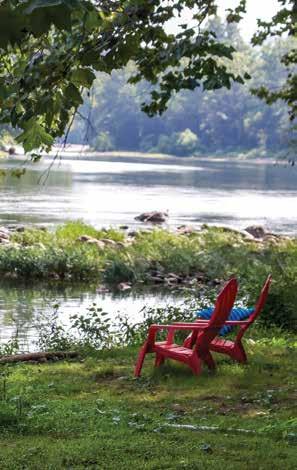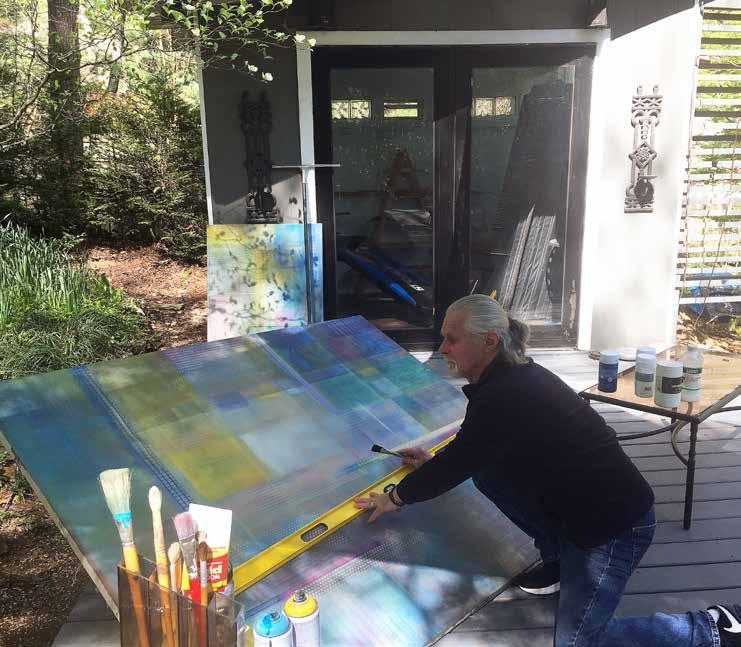
10 minute read
NRV Mushroom Club
Mycology for Fun and Delectability
Text by Becky Hepler Photos courtesy of NRV Mushroom Club
Advertisement
NRV Mushroom Club
Even though she’s heard it before hundreds of times, Rebecca Rader, president of the New River Valley Mushroom Club, does NOT roll her eyes when a newbie tells her: “I want to join because I’m a fungi.” She takes it in stride because, “…(those jokes) just reflect that a new person has been turned on to the wonderful world of fungi, which is great! Every joke is a reflection of newfound enthusiasm for mushrooms and mycology,” she says. There is a local group which meets monthly for people who want to learn more about mycology and how to identify mushrooms for cooking or medicine. NRV Mushroom Club meets monthly to hear speakers and plan forays into the woods to look for these specialists in the cycle of life in the natural world. Neither plant nor animal, mushrooms and fungi exist to break down dead plant and animal matter and return the nutrients to the soil to feed more plants that will feed more animals. It all started with some people, many inspired by former Virginia Tech mycology professor Orson Miller, who would get together on walks to look for different fungi. In 2008, they organized enough to find a place to meet. [see sidebar for details] Forays into the woods are planned for April through September or October, and the club sponsors two a month - one during the week and one on the weekend. At least one knowledgeable club member is assigned to each walk, so the found mushrooms can be identified and catalogued. This lets members contribute to the larger body of knowledge about mycology, submitting the results to mushroomobserver.org, according to communications chair Ava Pope. Some of these finds can be quite amazing. “We stumbled upon this tree that had a bunch of dead flies hanging on the branches. Upon closer look, they were infected with this kind of fungus that had taken over their bodies and gotten them to land on this tree and die and spread their spores,” she relates. In addition to planning forays, the meetings include speakers who help educate the group. Walt Sturgeon, author of Appalachian Mushrooms, spoke on what mushrooms are found here. Shannon Nix, a fungal ecologist at George
Dead fly on mushroom




Bears head tooth mushroom

Mason University, hosted a MycoJeopardy event at one of the meetings. She will also be giving an online talk entitled “The Great Escape - the science behind mushroom spore dispersal.” While based in the New River Valley, the club draws members from all across the region and state, according to Pope. The club also travels, using the community kitchen, Plenty, in Floyd for their cooking workshops and using one member’s house who lives in Botetourt County for the mushroom cultivation workshop. The club sponsors events such as the one night screening of “Fantastic Fungi” at the Lyric last December. The film was so popular, selling out the Lyric, that it boosted people interested in joining the club at the January meeting. The club also co-sponsored with the Mycological Association of Washington, D.C., the 2016 NAMA Shenandoah Foray. Rader explains its significance: “The annual event had never been held in Virginia, so it was wonderful to be a part of that.” There are thousands of varieties of mushrooms and many yet to be discovered and studied, but only about 20 varieties in Virginia are suitable for eating. Both Pope and Rader strongly assert that no mushroom should be eaten unless you are absolutely positive what it is. This is why foraging with a club or a very good field guide is always necessary. Morels, those early spring beauties that taste like steak when sautéed in butter, are the favorites, but there are 19 other varieties with their own charms. Oyster mushrooms don’t taste like their namesake, but chicken-ofthe-woods mushrooms indeed do, and both are delicious when properly cooked. The annual cooking workshop is a favorite event for the club with several members volunteering to prepare a couple of dishes with their latest finds and the rest contributing to a potluck dinner. The mushroom cream sauce recipe [see sidebar] was featured at one of these workshops. Rader considers the club a perfect metaphor of its subject. “The best thing about the club for me is seeing the spark of excitement spread and grow exponentially. It travels like hyphae, joining others to become mycelia, enveloping the roots of the community, pulling sustenance from the established trees and nourishing the seedlings, fruiting and attracting new minds and hearts. I love the feeling that we are building a platform from which brilliant minds of a new generation can spring. I absolutely believe that mushrooms can save the world.”
Recipe!
Mushroom Cream Sauce
This basic sauce can be used with any meat, especially steak, as a sauce for pasta with or without meat, or as a base for mushroom soup. You can use any type or combination of mushrooms - it is especially good with foraged chanterelles. Serves two to four people and can be easily scaled for more.
8 oz. of mushrooms, cleaned and sliced, with stems removed 1/4 lb. butter 1/2 diced medium yellow onion (chopped garlic may also be added) White wine 1/2 to 1 cup of broth (to suit its use) 1/2 cup heavy whipping cream Salt and pepper to taste 3 -4 Tbl. chopped parsley
Melt butter in skillet, add mushrooms and onions. Sauté until onions are transparent and mushrooms have released their liquid. Add garlic and sauté for another 30 seconds. Add wine to deglaze and cook till reduced; this will be creamy. Add broth and simmer 10 minutes. Add cream and simmer until thickened. Season with salt and pepper to taste. Finish with parsley and enjoy.
If you are interested in joining the NRV Mushroom Club, which is necessary to take part in workshops and events, check out the link below. Membership is $15 per year single; $20 for a family.
https://groups.google.com/ forum/#!forum/NRVMC
Meetings: 7 p.m., 3rd Wednesday each month Place: Community Room at Montgomery County Health Dept, Christiansburg Pandemic alert: Meetings have been temporarily suspended. Check the website.
www.VirginiasMtnPlayground.com





Chroma-Extraordinaire a 3-act biography
If Truman Capone’s life were a 3-act play, Act One would open in an elementary school in Pittsburgh. His artistic talent was recognized at a young age when he won contests for kids like drawing a poster for the humane society

Text by Joanne M. Anderson Photos courtesy of Truman Capone
or a mural at school. “I don’t remember a time in my entire life when I wasn’t drawing,” he relates. He was named art director for a school mural and had the weighty responsibility of choosing which kids got to work on it with him. “It’s like picking who plays on your kickball team, being pressured at times to select the one you know can’t kick or run, or in this case, draw or paint,” Truman recalls. Those events provided early lessons in diplomacy which helped


For 32 years, Truman Capone, who holds the rank of 5th Degree Black Belt in Aikido, has served at the Chief Instructor of Kodokan Aikido at Virginia Tech.


shape his keen evaluation of skills and personalities. The later part of Act One features a 12-year-old Truman enrolled at St. Joseph Art Academy. Though an art school, he followed a business track. In Act Two, Truman Capone is working as a short order cook, married to Faith Capone, the salad girl at the same restaurant. Both have art degrees from the prestigious Edinboro University where he went on a wrestler scholarship to major in economics. Once he took an art class, he switched his major and never looked back. He met Faith (proprietress of Capone’s Jewelry in downtown Blacksburg) fittingly in a jewelry making class in college. “We may not have been sure where we were going,” he explains, “but we both knew our uncertain future was definitely not in the restaurant business.” Virginia Tech’s College of Architecture and Urban Studies caught Truman’s attention, and Act Three opens in Blacksburg with the Capones having left their native Keystone State. While architecture was intriguing, Truman’s creative spirit felt a little cramped. As family life arrived, he took a job doing biomedical illustration at the VirginiaMaryland Regional College of Veterinary Medicine. He worked there more than a decade, assisting with hiring fellow artist and well-known portrait artist, Leslie Roberts Gregg. “I found Truman to be one of the most creative, inspirational individuals I have ever worked with,” states Gregg. “He is highly skilled and when presented with a challenging project, he always had a unique approach and great vision on how to make it successful. He was a wonderful artist, but once he had time to concentrate on his own art creations, his
work in the fine arts took off.” On the side, Truman was sketching, painting and teaching, but to step into Virginia Tech’s tenure Visual Community Design program, he needed the coveted Masters in Fine Arts. Once he finished his MFA degree at Radford University, he was instrumental in founding and teaching in VT’s School of Visual Arts (SOVA). He even had studio space, small studio space, in a basement, in an old building on campus. But hey, it was still a symbol of his validity as a genuine artist. With his architectural and construction knowledge, he has expanded their home to include an outdoor studio space built to meet his artistic parameters, interior and exterior utilization depending on the scale and mediums being used in his creations. These studio spaces were modeled after Penland School of Art in North Carolina
where he and Faith spent summers in the early 1970s. Chrome has come into English via French from the Greek words chrôma for color and chrōmos “having color”. Known internationally for his Chromatic Helix and Chroma Series paintings and his collages, Truman Capone has shown and won awards all over the world. When asked his favorite colors, he replies: “Reds, blues, primary colors,” and his favorite media are watercolor and acrylic or some combination. Truman’s art life has paralleled his spiritual journeys and intense interest in Japanese martial arts. “His athleticism and discipline are huge parts of who he is,” Faith explains. “Art is physical, and his formalized and ongoing Zen training and teaching in the internal art of Aikido has brought harmony into his life and his painting. He likes being centered on the anagogical, something that doesn’t exist and has mystical sublime
qualities.” And that explains the abstract visuals, atmospheric use of colors, all independent creations, some requiring 40 layers of paint as the entire work flows. “Faith often tells me when an art piece is done,” he says. “It actually speaks back and communicates closure.” “The backgrounds have both geometric and random qualities, and he knows that the high chroma – reds and yellows, contrasted with green and blue – has universal appeal,” states admiring artist Charles Anderson. “His work employs exceptional color schemes within the overlapping boundaries of geometric shapes.” “The current mixed-media creations merge traditional and digital media,” Truman explains. “The aesthetic catalyzes emotional, historical, spiritual and mythical elements, while rendering dimensions of color and geometry with emotive atmospheric connotations. I have synthesized two traditions: Zen
in collaboration with the esoteric and sublime, creating an abstract aesthetic of eastern and western expressionism.” “Recently,” he continues, “I have been developing new approaches to my methodologies thus incorporating 3D and 2D mediums, spontaneous causation and the use of creative technologies to bring satisfying outcomes with transcribing energies.” So we conclude Act Three with a retired professor emeritus enjoying his home studio, practicing and training others in Aikido and expanding his spiritualism in an abstract, yet somehow organized, chromatic artistic expression.
My favorite inspirational artists include Mark Rothko, Barnett Newman, Isamu Noguchi and Richard Diebenkorn. – Truman Capone












